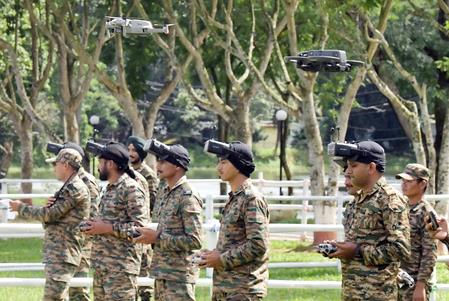
'SAKSHAM': India's New Eye In The Sky To Neutralise Aerial Threats
According to defence officials, the system is designed to“detect, track, identify, and neutralise hostile drones and unmanned aerial systems in real time, ensuring complete airspace security across what is now defined as the Tactical Battlefield Space (TBS), an expanded domain that includes the Air Littoral, the airspace up to 3,000 metres (10,000 feet) above the ground.”
It is pertinent to note here that the necessity for a comprehensive counter-UAS framework emerged prominently during Operation Sindoor, where hostile UAS activity highlighted the need for“swift detection, coordinated response, and airspace control beyond traditional ground limits”.
“The Indian Army has since evolved its operational concept from the earlier Tactical Battle Area (TBA) to the more inclusive Tactical Battlefield Space (TBS), recognising that future wars will be fought not just on land but also in the air littoral directly above it,” said an official.
This new approach ensures that the airspace up to 3,000 metres above the ground, the Air Littoral, remains under the control of ground forces, allowing unrestricted movement for friendly aerial assets while detecting, tracking, and neutralising hostile drones or aircraft.
Notably, in the domain of modern warfare, particularly the Russia-Ukraine war, Israel-Palestine, Israel-Iran conflict and also seen during the operation Sindoor, wherein Pakistan fired nearly 400 drones (which were all neutralised by the security forces), modern conflicts have increasingly involved drones for surveillance and attacks.
Conceived as a high-end, modular Command and Control System, SAKSHAM, short for Situational Awareness for Kinetic Soft and Hard Kill Assets Management, has been developed in collaboration with Bharat Electronics Limited (BEL), Ghaziabad.
Saksham aims to provide integrated situational awareness for counter-UAS management through an effective CUAS network grid across the Tactical Battlefield Space.
It also aims to“integrate own and enemy UAS data, CUAS sensors, and soft/hardkill systems on a common GIS-based platform.”
Similarly, it will enable automated decision support and real-time visualisation for field commanders and will offer a modular, scalable, and flexible architecture, adaptable to evolving UAS threats.
Amongst its key capabilities, it includes AI-enabled threat analysis for predictive identification and faster decision-making.
The system is fully indigenous, embodying the government's vision of 'Aatmanirbhar Bharat' in defence technology.
Designed and developed by BEL, the system incorporates AI-driven fusion technologies for future combat systems, enabling scalability and upgradation as threat environments evolve.
To ensure speedy induction, the project has been approved under the Fast Track Procurement (FTP) route, with rollout to all field formations targeted within the next year.

Legal Disclaimer:
MENAFN provides the
information “as is” without warranty of any kind. We do not accept
any responsibility or liability for the accuracy, content, images,
videos, licenses, completeness, legality, or reliability of the information
contained in this article. If you have any complaints or copyright
issues related to this article, kindly contact the provider above.
Most popular stories
Market Research

- Pepeto Presale Exceeds $6.93 Million Staking And Exchange Demo Released
- Citadel Launches Suiball, The First Sui-Native Hardware Wallet
- Luminadata Unveils GAAP & SOX-Trained AI Agents Achieving 99.8% Reconciliation Accuracy
- Tradesta Becomes The First Perpetuals Exchange To Launch Equities On Avalanche
- Thinkmarkets Adds Synthetic Indices To Its Product Offering
- Edgen Launches Multi‐Agent Intelligence Upgrade To Unify Crypto And Equity Analysis



















Comments
No comment